Crawling Back: Amazing Spider-Man #129 Review
An iconic character is introduced in an issue which allows the Punisher decent moral ambiguity
—by Nathan on October 12, 2025—
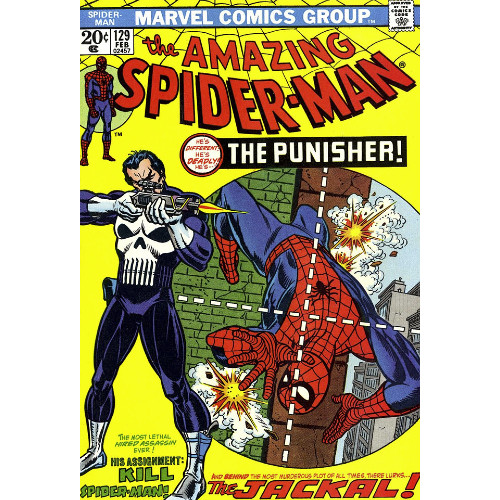
Last post, I checked out the late 80s/early 90s solo adventures of one Frank Castle, as told in the first nineteen issues of Punisher: War Journal by Carl Potts, Jim Lee, and others. As I read that volume, it occurred to me that, though I've discussed the Punisher and his one-man war on crime in posts covering his tempestuous team-ups with Spider-Man, his first-ever solo series, and most recently, a guest appearance in a Venom limited series, I have not yet covered the Vietnam vet's original appearance in the 70s.
The Punisher was a creation of several individuals–the brainchild of Amazing Spider-Man writer Gerry Conway, Castle's alter ego was given his moniker by Stan Lee and was designed by John Romita, who specifically changed one aspect of an early design, plastering the vigilante's iconic skull across his entire chest. Conway wanted a character that captured the zeitgeist of the era, replicating in comics the slew of "vigilante justice" style narratives popularized through novels and film. Castle wasn't a villain, but he wasn't exactly a hero either…he was somewhere in-between, a notion other characters introduced in 1974, such as Wolverine and Deathlok, would also reflect. The "anti-hero."
I don't know what other titles, other than ASM and Fantastic Four, Conway was writing for Marvel at the time, if any, but I assume that he felt it logical to introduce this "anti-hero" in Marvel's flagship series. At first blush, a gun-toting vigilante debuting in a series centered on a wise-cracking college student feels somewhat odd. A deeper glance finds the violent heroism a more appropriate subject to broach at this time: Spidey was a suspect in the possible murder of Norman Osborn, the Green Goblin, himself responsible for the recent death of Gwen Stacy. With those losses lingering in Peter's mind, a guy with a big skull on his chest is kind of a perfectly bitter adversary to bother him with.
"The Punisher Strikes Twice"
Writer: Gerry Conway
Penciler: Ross Andru
Inkers: Frank Giacoia and Dave Hunt
Colorist: Dave Hunt
Letterer: John Costanza
Issue: Amazing Spider-Man #129
Issue Publication Date: February 1974
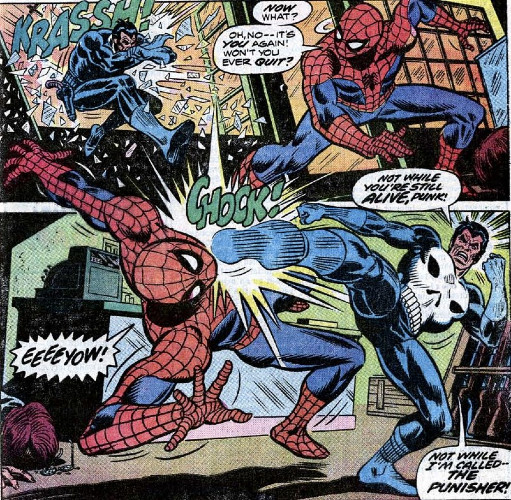
I have talked, in other posts about Spidey/Punisher stories, how tired I've become of the incessant "Killing people is wrong, Frank," arguments we get. I completely agree with Spidey's viewpoint, but the argument never moves past the problem. Frank never throws his guns away or gets shipped to prison for an indefinite period of time. Dude will actually kill criminals already in prison and then break out so he can kill criminals who aren't. You're not winning this debate, Spidey.
What strikes me as interesting regarding the Punisher's debut is that Conway has already considered a multi-faceted approach to the vigilante, better than later writers would handle him. Hired to kill Spider-Man at the behest of the Jackal, who convinces him of Spidey's criminal status, Castle appears to be more morally divided than I would have initially believed. He's a man on a deadly mission, but he isn't quite the die-hard killer other people write him as. Or, at least, he isn't at the "shrug off the morals of murdering scumbags because those guys are murdering scumbags themselves" stage of his career.
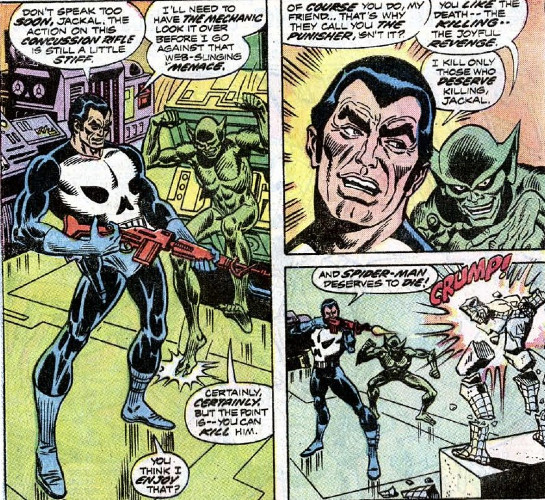
Conway genuinely allows Castle to wrestle with his actions. Oh, he'll come to the same conclusion–just keep murdering those scumbags–but there is a sense he puts great stock into appreciating or anticipating his own downward spiral as a result. "You like the death, the killing, the joyful revenge," the Jackal sneers early in the issue, which Castle refutes. However, he is concerned about being tainted. "Sometimes I wonder if that evil's rubbed off on me, but I know it doesn't matter," he later admits to Spidey. "All that matters is the job." There is very clearly a moral conundrum at play, and though the Punisher approaches his divisive techniques through his own justifiable philosophy, he's aware of the repercussions. He's adamant he hates the way in which he works, something I don't think could be said about the character's later incarnations, and he's not deaf to reason either, as seen later in the issue.
You could perhaps create the argument that he's a tad too easily persuaded by the Jackal. We don't see the process of Miles Warren's costumed side hiring or convincing Frank to pursue Spider-Man–as the issue opens, Castle's already determined to go gunnin' after the Web-Head. "Spider-Man deserves to die," he says, even if hints are given he's not quite as passionate about the prospect as the Jackal is. Still, he's being asked by one guy in a mask and full-body stocking to go after another dude in a mask and full-body stocking. I'm not saying Castle needs to be presented as a completely stable individual–Conway does allow some emotion to override his reason late in the issue–but the argument could be made that he should be a little less trusting of the Jackal. They get into a spat later, but this is purely over methodology. Not until much later in the issue does the Punisher question if going after Spidey is the right move, and I feel at least some tension could have been generated from that point.
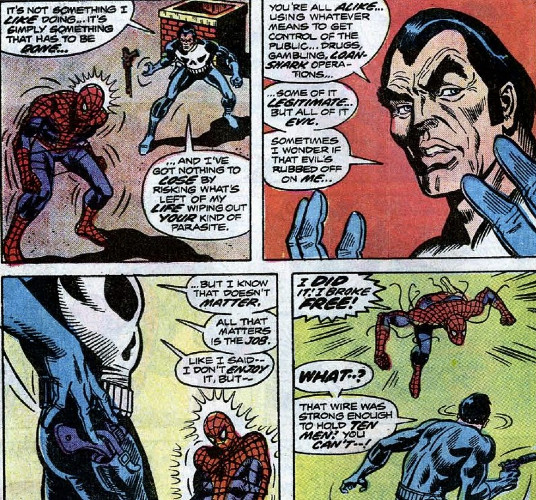
I've discussed the Punisher quite a bit already, so (to paraphrase Stan Lee) "lest you forget whose blog this is really about," let's turn our attention to the guy whose name appears biggest on the cover. Peter's in an interesting spot as this issue opens–as I mentioned, his girlfriend has recently been killed, and the guy who killed her died at his own hand. Meanwhile, his roommate, Harry Osborn, knows Peter is Spidey and believes Peter is his enemy. So, y'know, not a great place to be. Conway had dealt with some of the emotions over Gwen and Norman's deaths in the issue immediately following Norman's "self-inflicted demise," but here, we find Peter in an interesting middle space.
We're shown that some healing may be going on, that Peter's not quite past Gwen's loss but is moving in a positive direction. He chats and jokes with Betty Brant, accepts an invite from her to a Christmas party, and teases J. Jonah Jameson some. Yet immediately before this scene, in my favorite moment in the issue, Andru draws a more serious Peter throwing on a brief smile before Conway has the young man ask why he's gotta be happy all the time. It's an incredibly interesting dichotomy, and though I don't think we're meant to believe that Peter's joking and teasing with Betty and Jonah is disingenuous, we're not supposed to believe he's back to 100%. The brief smile is a quick moment, a reorientation of Peter's mood, but it's telling as to Peter's state of mind. The smile and wit, which usually come so naturally to him, is an aspect, at least at this moment in time, which Peter has to work to embrace. He's not putting on a completely fake show, but he's consciously fitting the mold of how he believes he's supposed to appear socially. True healing is just going to take time, and as both Peter and Spidey, our guy should be allowed his moments of melancholy, even if his gut reaction is to behave more cheerily.
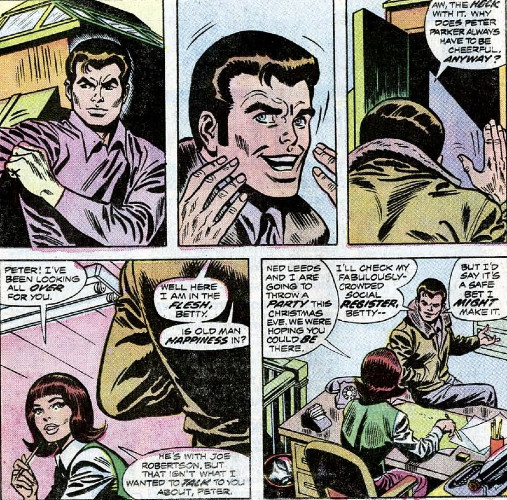
The Punisher is the issue's selling point, but Conway and Andru make sure to remind us of another important facet. The jumping Jackal makes his debut in this issue, and even if his first appearance isn't quite as iconic as our vet-turned-vigilante, he'd be destined to play some significant roles later, like kicking off the original Clone Saga. I have no idea if Conway had pinpointed the Jackal's identity at this stage, but with hindsight, a scene where Professor Miles Warren asks Mary Jane Watson as to Peter's whereabouts reads differently once you know the truth–the seemingly kindly professor's innocuous request takes on a more sinister edge. A cut to a scene between the Jackal and the Punisher immediately following the Professor Warren/MJ interaction may muck with the timeline, but in retrospect, we can just expect some time to have passed, even if Conway doesn't indicate it does. If all of this is Conway sewing seeds for the later revelation, he does so fairly well–maybe he expected readers to assume the Punisher/Jackal sequence immediately follows the Warren/MJ interaction and intentionally threw them off?
That's all I'll say about the Jackal for now, as he will become increasingly important as we near the 90s Clone Saga…
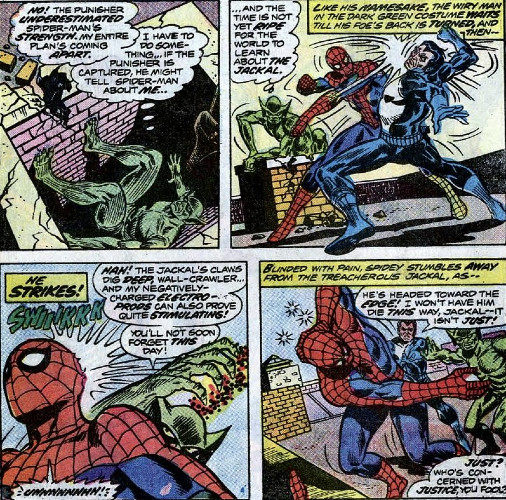
Elements around the Punisher would still need to be founded; we don't yet have his origin story, for one. Conway notes Castle's experiences with the Marines, but we receive no specific connections to Vietnam or anything regarding his family. Those pieces would be laid later once Marvel realized they didn't just have a "one-shot" anti-hero on their hands. It's no surprise the character stuck around. Not only does he exemplify a changing notion of the shifting definition of "justice" in media at the time, he provides some moral complications through his applications of justice and looks pretty cool to boot (Romita having his ammo pouches serve as the skull's "teeth" is a darn awesome design choice). He'd run afoul of Spidey several more times in the future, to the point where their frenemy relationship would get a little tiring. In 1974, however, Frank Castle was a fresh addition to the Marvel roster, straddling the line between costumed bad guy and hero who you may have a slightly harder time rooting for.